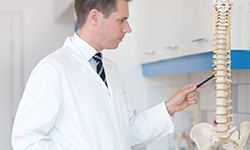Spine

The spine reaches from the head down to the pelvis and works as a dynamic stabilizer of the whole body and protects the spinal cord. It is a complex formation consisting of bones, tendons, muscles, joints, cartilage and nerves.
All parts of the spine are permanently loaded during the whole lifetime and can cause pain. It is not surprising that back pain is one of the most frequent disorders of the musculoskeletal system. 80% of the current population are at least once in lifetime affected by this condition. For me it is very important to locate the source of the pain. I frequently perform fluoroscopy guided corticoid injections as part of a multi-modal therapy concept which is tailored to your individual needs.
Common causes for back pain are:
- Unspecific back pain: In most cases back pain lasts only for a few weeks and disappears without detecting a damaged anatomical structure. This condition is called „unspecific back pain“ and is frequently caused by physical overload, lack of physical training, office work in a sitting position or extensive exercise. The pain is caused by asymmetric vertebral muscle seizures and contractions which often leads to an asymmetric overload of the small facet joints of the spine.
- Lesions of the intervertebral disc: A Herniated Intervertebral Disc often causes intense pain with acute onset which irradiates to the upper or lower limb. In some cases the pain is accompanied by neurological deficits like numbness or reduced force.
- Joint wear of the facets: Arthritis of the small facet joints can occur after years of chronic overload. Most of the patients complain about chronic lower back pain.
- Narrowing of the vertebral canal: The spinal cord and the nerve roots are protected by tendons and a bony canal. Swollen tendons and bulging vertebral discs can compress this canal (Spinal stenosis) and cause a typical lower back pain which extend to both legs.
To find the correct diagnosis it is important to have a detailed interview and an exact clinical examination. Standard radiographs and magnet resonance imaging (MRI) are necessary in most cases of chronic back pain to assess the anatomical structures of the spine.
Each episode of back pain needs an early and sufficient treatment. After having the exact diagnosis I develop a personalized therapy plan, tailored to your individual needs. Usually it consists of physiotherapy, analgesic medication, remedial exercises which are taught by a specialized physiotherapist. An important factor of this multi-modal therapy are fluoroscopic guided corticoid injections which treat the pain directly at its source.
In rare cases spine surgery is inevitable. To ensure a high quality, state of the art treatment I closely collaborate with two specialized spine surgeons.

